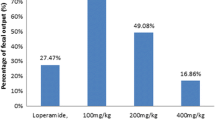Abstract
Ethanol extract of the of rhizome of Nymphaea alba, at graded doses was investigated for anti-diarrhoeal activity in term of reduction in the rate of defecation in castor oil induced diarrhoea and anti-inflammatory activity in term of reduction in inflammation of rat paw. To understand the mechanism of its anti-diarrhoeal activity, its effect was further evaluated on intestinal transit and castor oil induced intestinal fluid accumulation (enteropooling). At various doses (100 & 200 mg/kg body weight) the extract showed a remarkable anti-diarrhoeal activity evidenced by the reduction in the rate of defecation. Results are comparable to that of standard drug diphenoxylate (5 mg/kg body weight). A single oral dose of N. alba extract of 100 mg/kg body weight produced a significant decrease in the severity of diarrhoea. Extract produced profound decrease in intestinal transit (25.73 and 37.29%) also significantly inhibited castor oil induced enteropooling comparable to that of intraperitoneal injection of standard drug atropine sulphate at doses of 0.1 mg/kg body weight and loperamide at 5 mg/kg body weight respectively. Results indicate N. alba possess significant anti-diarrhoeal activity and may be a potent source of anti-diarrhoeal drug in future. But the extract did not show anti-inflammatory activity.

Similar content being viewed by others
References
Ammon PJ, Thomas PS (1974) Effects of oleic and recinoleic acids net jejunal water and electrolyte movement. J Clin Invest 53:374–379. doi:10.1172/JCI107569
Awouters F, Niemegeers CJE, Lenaerts FM, Janssen PAJ (1978) Delay of castor oil induced diarrhoea in rats; a new way to evaluate the prostaglandin synthesis. J Pharm Pharm 30:41–45. doi:10.1111/j.2042-7158.1978.tb13150
Black RE, Brown KH, Becker S, Yunus M (1982) Longitudinal studies of infectious diseases and physical growth of children in rural area of Bangladesh. Am Epidemiol 115:305–314
Chitme HR, Chandra R, Kaushik S (2004) Studies on antidiarrheal activity on calotropis gigantean R.BR. in experimental animals. J Pharm Pharmaceut Sci 7(1)):70–75
Di Carlo G, Autore G, Izzo AA, Maibline P, Mascolo N (1993) Inhibition of intestinal motility and secretion by flavonoids in mice and rats: structure activity relationships. J Pharmacol 45:1054–1059. doi:10.1111/j.2042-7158.1993.tb07180.x
Galvez J, Zarzuelo A, Crespo ME, Lorente MD, Ocete MA, Jimenez J (1993) Antidiarrhoeic activity of Euphorbia hirta extract and isolation of an active flavonoid constituent. Planta Medica 59:333–336. doi:10.1055/s-2006-959694
Harborne JB (1998) Phytochemical methods, a guide to modern techniques to plant analysis, 3rd edn. Chapman and Hall, London, pp 60–66
Hesham A, Abdel NB, Jari S, Kalevi P (2005) Hypolipidemic and antioxidant effect of Morus alba L (Egyptian mulberry) root bark fractions supplementation in cholesterol- fed rats. J Ethnopharmacol 78:2724–2733
Kang TH, Oh HR, Jung SM, Ryu JH, Park MW, Park YK (2006) Enhancement of Neuroprotection of Mulberry leaves (Morus alba L.) prepared by the Anaerobic treatment against ischemic damage. Biol Pharm Bull 29:270–274. doi:10.1248/bpb.29.270
Longanga Otshudi A, Vercruysse A, Foriers A (2000) Contribution to the ethnobotanical, phytochemical and pharmacological studies of traditionally used medicinal plant in the treatment of dysentery and diarrhea in Lomela area, Democratic Republic of Congo (DRC). J Ethnopharmacol 71(3). doi:10.1016/S0378-8741(00)00167-7
Mora A, Paya M, Rios JL, Alcaraz MJ (1990) Structure activity relationships of polymethoxy flavones and other flavonoids as inhibitors of nonenzymic lipid peroxiation. Biochem Pharmacol 36:317–322
Mukherjee PK, Saha K, Murugesan T, Mandal SC, Pal M, Saha BP (1998) Screening of anti-diarrhoeal profile of some plant extracts of a specific region of West Bengal. Ind J Ethnopharm 60:85–89
Naghma K, Sarwat S (2005) Inhibition of potassium bromate-induced renal oxidative stress and hyperproliferative response by Nymphaea alba in Wistar rats. J Enzym Inhib Med Chem 20:275–283
Nwodo OFC, Alumanah EO (1991) Studies on Abrus precatorious seed II: antidiarrhoeal activity. J Ethnopharm 31:395–398. doi:10.1016/0378-8741(91)90024-8
Pierce NF, Carpentor CCJ, Ellior H, Greenough WB (1971) Effect of prostaglandin, heophyllin and cholera exotoxin upon transmucosal water and electrolyte movement in canine jejunum. Gastroenterology 60:22–32
Rao VSN, Santos FA, Sobreika TT, Souza MF, Melo LL, Silveira ER (1997) Investigation on the gastroprotective and antidiarrheal properties of ternatin,a tetramethoxyflavone from Egletes viscose. Planta Med 63:1496–1497. doi:10.1055/s-2006-957632
Robert A, Nezamis JE, Lancaster C, Hanchar AI, Klepper MS (1976) Enteropooling assay: a test for diarrhoea produced by prostaglandins. Prostaglandins 11:809–814
Robin D (2001) Nymphaea odorata: white pond lily. Medical herbalism. Materia Medica Pharm 11:231–233
Sanchez de Medina F, Galvez J, Gonzalez M, Zarzuelo A, Barrett KE (1997) Effects of quercetin on epithelial chloride secretion. Life Sci 61:2049–2055. doi:10.1016/S0024-3205(97)00863-1
Satyanarayana D, Joshi AB, Chandrasekhar KS, Vijayanarayana K (2004) Antiinflammatory activity of the flowers of Tabernaemontana divaricata(L) R.BR. Indian Drugs 41(7):405–407
Su YL, Leung LK, Bi YR, Huang Y, Chen ZY (2000) Antioxidant activity of flavonoids solated from Scutellaria rehderiana. J Am Chem Soc 77:807–812. doi:10.1007/s11746-000-0129-y
Syder JD, Merson MH (1982) The magnitude of the global problem of acute diarrhoeal diseases: a review of active surveillance data. Bull WHO 60:605–613
Tijani AY, Uguru MO, Salawu OA (2008) Anti-pyretic, anti-inflammatory and anti-diarrhoeal properties of Faidherbia albida in rats. Afr J Biotechnol 7:696–700
Trease GE, Evans WC (1983) Pharmacognosy, vol 387, 12th edn. Baillere Tindal London, London, pp 475–476
Venkatesan N, Thiyagarajan V, Narayanan S, Arul A, Raja S, Kumar SGV (2005) Antidiarrheal potential of Asparagus racemous wild root extracts in laboratoire animals. J Pharm Pharmaceut Sci 8(1):39–45
Vergeera LH, Vander VG (1997) Phenolic content of daylight-exposed and shaded floating leaves of water lilies (Nymphaeaceae) in relation to infection by fungi. Oecologia 112:481–484
Watson WC, Gordon R (1962) Studies on the digestion absorption and metabolism of castor oil. Biochem Pharmacol 11:229–236. doi:10.1016/0006-2952(62)90078-3
Author information
Authors and Affiliations
Corresponding author
Rights and permissions
About this article
Cite this article
Bose, A., Sahoo, M. & Ray, S.D. In vivo evaluation of anti-diarrheal activity of the rhizome of Nymphaea alba (Nymphaeaceae). Orient Pharm Exp Med 12, 129–134 (2012). https://doi.org/10.1007/s13596-012-0062-6
Received:
Accepted:
Published:
Issue Date:
DOI: https://doi.org/10.1007/s13596-012-0062-6




